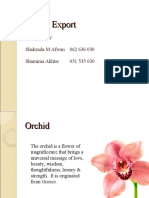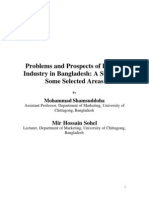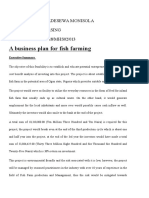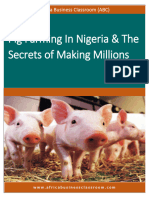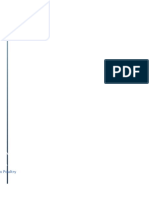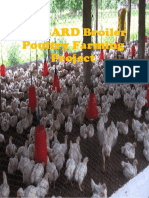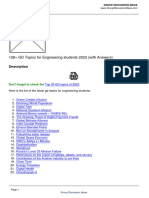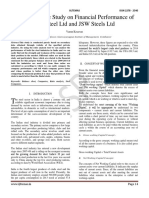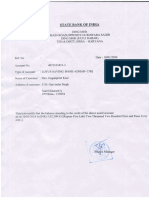MPP Goat Farming
MPP Goat Farming
Uploaded by
gavinilaaCopyright:
Available Formats
MPP Goat Farming
MPP Goat Farming
Uploaded by
gavinilaaOriginal Title
Copyright
Available Formats
Share this document
Did you find this document useful?
Is this content inappropriate?
Copyright:
Available Formats
MPP Goat Farming
MPP Goat Farming
Uploaded by
gavinilaaCopyright:
Available Formats
MODEL PROJECT PROFILES FOR GUIDANCE OF CHANNELISING AGENCIES OF NSTFDC AND SCHEDULED TRIBES
NATIONAL SCHEDULED TRIBES FINANCE AND DEVELOPMENT CORPORATION NBCC Tower, 15 Bhikaji Cama Place, New Delhi-110 066
Project Profiles
GOAT FARMING
1. Introduction
Goat is usually referred to as the cow of the poor. Rearing of goat is easy and can be done by landless labourers, women and children. Goat has the ability to survive on little vegetation and grass. Goat farming suits Indias climate and economic situation. This is evident from the fact that every year 1/3rd of goats are slaughtered. But the population has been constantly rising. It was 40.7 million in 1951 and now India has a goat population of 115 million as per the 1992 census. The contribution of goatery to the country can be gauged from the following facts: Yearly production of goat milk Yearly production of meat Leather 1.5 million tonnes 0.4 million tonnes 0.1 million tonnes
The main breeds of goats available in the country are Jamuna Pari, Beetal, Bar Bari, Sirohi, Osmanabadi, Jhakarna and Sanganeri. Different breeds are found in different parts of the country. Depending on the objective, meat or milk, the breeds are selected so as to earn maximum profits. Major breeds of goats, their region and milk yield is given in the table below: S. No. Breed Region Quantity of milk yield/day (in litres) 1 1 2 0.7 1 1.4
1. 2. 3. 4. 5. 6.
Beetle Jamuna pari Jhakarana Barbari Mulabari Surati
Punjab On the bank of Jamuna and chambal river Rajasthan, Haryana Haryana and Delhi Kerala Maharashtra
Project Profiles
Besides these breeds, there are other breeds as well like Sitren that yield 3.3 litre of milk, Alpine breeds yield 2.5 litres of milk and Taganvery yields 2 litres everyday. These high quality breeds are crossed with indigenous breeds to produce economically more viable breeds. Project start-up recommendations are: Unit Size Breeds Typical Location 2. Market potential 50 does (She goats) 2 Bucks (He goats Osmanabadi) Andhra Pradesh, Karnataka, Maharashtra
Goat meat has no religious inhibitions and is consumed by all the religions and races in the country. Goat milk is source of cheap protein for the poor people and has medicinal properties. Goats are also major sources of leather and leather products in the country. Goats are simple creature and live in the domestic environment. Goats can be reared commercially and such venture is viable and may form source of livelihood and extra income for poor people in the villages. Goat farming thus provides a good source of living and has great potential in most part of the country. 3. (a) Technical details Space requirement
Goats prefer clean, dry and solid floor; wet places affect their milk production. They need cheap shelter to protect them from the vagaries of Nature like rain, winter etc. the requirement of space and its cost is furnished in the table below: S. No. 1. 2 3. Type of goat Does Bulk Kids Quantity Space requirement/ animal sq. ft 10 20 4 Total space requirement sq. ft. 500 40 272 Rate/ sq ft. 40 40 40 TOTAL SAY Total cost (in Rs.) 20,000.00 1,600.00 10,880.00 32,480.00 32,500.00
50 2 68
Project Profiles
(b) S. No. 1. 2
Cost of animals Goat Does Bucks Rate 50 @ Rs. 900 each 2 @ Rs. 1100 each TOTAL Total cost (in Rs.) 45,000.00 2,200.00 47,200.00
(c) S. No. 1. 2. 3. 4. 5. 6. (a) S. No. 1. 2. 3. 4.
Main assumptions made for the project Items Kidding interval Age at maturity Kidding percentage Twinning No. of Kiddings per year Sex ratio (male : female) Production target (Annual) Items Adult Does Buckling Doeling Feed requirement Traditionally goats reared in villages are not given much attention towards their feed and fodder. However, for proper breeding, attention needs to be paid to the feeding requirement, which will be green fodder and concentrate comprising channa (gram) and moong chaff, gur etc. Male goats require maximum feed followed by pregnant goats and kids. The cost of green fodder is estimated as Rs.1000/- per month Once in year, concentrate requirement will be 2 months for does, 2 months for bucks and 1 month for kids at a price of Rs.4 per kg. The calculations are as under: Goat Requirement per animal (kg.) 6.75 7.5 3.75 Total requirement Cost per kg (in Rs.) 4 4 4 TOTAL SAY Total cost (in Rs.) 2,700.00 120.00 1,020.00 3,840.00 4,000.00
8 months 12 months 85 60% 1.5 1:1
10 55 42
S.No.
1. 2. 3.
Does Bucks Kids
6.75kg 2 months 50 heads 7.5 kg 2 months 2 heads 3.75 kg 1 month 68 heads
Total feed requirement Rs.12000 + 4000 = 16000 per annum
Project Profiles
5. S. No. 1. 2. 3.
Working capital requirement Items Feed cost: concentrate and green fodder for one month Labour cost self (15 days) Others TOTAL SAY Cost of project Items Land development (L.S.) Cost of thatched roof shed etc. Miscellaneous equipment like buckets, tank etc. Cost of animals including transportation, insurance, etc. Miscellaneous and contingencies etc. Working capital TOTAL Means of finance Items Promoter's Contribution NSTFDC Term Loan SCA term loan/subsidy TOTAL Total cost (in Rs.) 2,000.00 80,000.00 18,000.00 1,00,000.00 %age 2.00 80.00 18.00 100.00 Total cost (in Rs.) 10,000.00 32,500.00 1,000.00 51,000.00 400.00 5,100.00 1,00,000.00 Total cost (in Rs.) 3,440.00 1,000.00 700.00 5,140.00 5,100.00
6. S. No. 1. 2. 3. 4. 5. 6.
5. S. No. 1. 2. 3.
Note: The State Channelising Agencies shall arrange to provide subsidy to beneficiary(ies) as per norms of their Corporation. Further, SCAs may also make efforts to avail incentive/subsidy from other centrally sponsored schemes. 6. Project economics From 2nd year of project Sales Realisation Sale of adult does 15 nos @ Rs.800/Sale of buckling 60 nos @ Rs.900/Sale of doeling 45 nos @ Rs.800/TOTAL Amount (in Rs.) 12,000.00 54,000.00 36,000.00 1,00,000.00
S. No. A. (i) (ii) (iii)
Project Profiles
B. (i) (ii) (iii) (iv) (v) (vi) C. D. E. 7. S. No. 1. 2. 3. 8. (a)
Cost of Production Fodder and feed cost Medicine Insurance Labour Wages Interest Misc. (Veterinary services etc.) TOTAL Cash profit Depreciation/Amortisation of expenses @10% Net Profit
16,000.00 1,000.00 2,000.00 24,000.00 5,880.00 1,280.00 50,160.00 49,840.00 9,500.00 43,040.00
Viability indicators Particulars Repayment per annum (period - 5 years) Return on investment (ROI) Debt service coverage ratio Interest, moratorium & repayment period for beneficiaries Interest : 6% p.a. on NSTFDC term loan chargeable from beneficiaries 12 months from date of release of final installment by SCA. 5 years excluding moratorium period. Amount (in Rs.) 19,600.00 43% 2.19
(b)
Moratorium period
(c) 9.
Repayment period Conclusion
Goatery is techno-economically viable income generating activity and suited for rural entrepreneurs. Notes:
The sex ratio of doeling to buckling is 1:1. Therefore, production of each is equal. But sale of doeling indicated is less as some doeling will be kept on the farm for future reproduction. Profitability may be improved by sale of goat milk wherever feasible. With each passing year profitability would improve further due to increase in number of animals.
Project Profiles
The cost of project may vary in different States & Regions. It is assumed that the goat rearing is suitable in the given locality.
You might also like
- Introduction To Caribbean Politics (Cynthia Barrow-Giles)Document303 pagesIntroduction To Caribbean Politics (Cynthia Barrow-Giles)Claire Cummins100% (3)
- Taro ProductionDocument63 pagesTaro ProductionOlivier BariauNo ratings yet
- Goat Fattening FarmDocument18 pagesGoat Fattening FarmZohaib Pervaiz100% (2)
- AA BroilerPerfObj2012R1 PDFDocument12 pagesAA BroilerPerfObj2012R1 PDFAmine FettahNo ratings yet
- Maggot FarmingDocument18 pagesMaggot FarmingJOSEPH REGINALDNo ratings yet
- Chicken Egg FarmDocument27 pagesChicken Egg FarmRocky MontañerNo ratings yet
- TMR Business PlanDocument19 pagesTMR Business PlanRuel PerochoNo ratings yet
- Orchid ExportDocument24 pagesOrchid ExportShaz AfwanNo ratings yet
- Farmer Field Schools for Family Poultry Producers: A Practical Manual for FacilitatorsFrom EverandFarmer Field Schools for Family Poultry Producers: A Practical Manual for FacilitatorsNo ratings yet
- Indyoheshabirayi Co. LTD TEL: +250 788300470 AHO UZAKORERA: Umurenge Wa GITI, Akarere Ka GICUMBIDocument54 pagesIndyoheshabirayi Co. LTD TEL: +250 788300470 AHO UZAKORERA: Umurenge Wa GITI, Akarere Ka GICUMBILambert Mwunguzi100% (1)
- Business Proposal: Godwith UdohDocument5 pagesBusiness Proposal: Godwith UdohGodwith UdohNo ratings yet
- Business Plan For Dairy Farm 30 Animals Final11Document17 pagesBusiness Plan For Dairy Farm 30 Animals Final11dauda kizitoNo ratings yet
- Marketing PlanDocument9 pagesMarketing PlanMuhammad AfzalNo ratings yet
- Rainbow Rooster Chicken EnterpriseDocument6 pagesRainbow Rooster Chicken EnterpriseWilfred MbithiNo ratings yet
- Farm Management, GRP 8Document25 pagesFarm Management, GRP 8Soumya RaniNo ratings yet
- Temo LetlotloDocument50 pagesTemo Letlotlothabo chuchuNo ratings yet
- Broiler Poultry Farming..Document8 pagesBroiler Poultry Farming..laurentveryniceNo ratings yet
- Aquaculture Funmilayo IbigbemiDocument40 pagesAquaculture Funmilayo IbigbemiAbiodun AliNo ratings yet
- Establishment of A Commercial Catfish and Tilapia Farm in Nigeria PDFDocument34 pagesEstablishment of A Commercial Catfish and Tilapia Farm in Nigeria PDFSegun AdebayoNo ratings yet
- Business DescriptionDocument6 pagesBusiness DescriptionTahir MumtazNo ratings yet
- Poultry Farm Business PlanDocument24 pagesPoultry Farm Business PlanAnwar jemal100% (2)
- Amoko Yamamazwa:: 2. IbitunguruDocument17 pagesAmoko Yamamazwa:: 2. IbitunguruBUCYEKABIRI100% (1)
- Idume Michael Ogbonna Business PlanDocument8 pagesIdume Michael Ogbonna Business PlanK-Tech SystemsNo ratings yet
- Piggery ProjectDocument28 pagesPiggery ProjectThe SniperNo ratings yet
- KeggFarms (India)Document18 pagesKeggFarms (India)msulgadle100% (1)
- Pig Farming BusinessDocument8 pagesPig Farming BusinessOni SundayNo ratings yet
- 4000 BroilerDocument10 pages4000 BroilerDanish JavedNo ratings yet
- Delice FannyDocument6 pagesDelice FannyUwase Jean EricNo ratings yet
- Business Plan 55Document12 pagesBusiness Plan 55Marrien100% (1)
- Economic Analysis of Feed Mill Enterprise in Akwa Ibom State, NigeriaDocument10 pagesEconomic Analysis of Feed Mill Enterprise in Akwa Ibom State, NigeriaUdeme UsangaNo ratings yet
- Problems and Prospects of Poultry Industry in BangladeshDocument16 pagesProblems and Prospects of Poultry Industry in BangladeshDr. Mohammad Shamsuddoha75% (4)
- 200 Profitable Agribiz Ideas in KenyaDocument345 pages200 Profitable Agribiz Ideas in KenyaMaurice OnyangoNo ratings yet
- Poultry Production and Marketing Project Kitui, KenyaDocument11 pagesPoultry Production and Marketing Project Kitui, KenyaPramod Kumar Chaudhary100% (2)
- Scovia PDFDocument25 pagesScovia PDFlaniNo ratings yet
- The Organic FarmerDocument9 pagesThe Organic FarmerHerman MwakoiNo ratings yet
- Piggary Model Project MPDocument11 pagesPiggary Model Project MPLalrempuia Lalrempuia100% (1)
- Goat Farming Project ReportDocument7 pagesGoat Farming Project ReportSamuel AlioniNo ratings yet
- Make The Chicken FeedDocument2 pagesMake The Chicken Feedruvarashe mandereNo ratings yet
- Business Plan LivestockDocument8 pagesBusiness Plan LivestockArthur Pentax0% (1)
- 8.business Plan of Srinagar Agro FarmDocument9 pages8.business Plan of Srinagar Agro FarmSantosh BhandariNo ratings yet
- Cost Estimates AgriDocument17 pagesCost Estimates AgriIan Bernales OrigNo ratings yet
- How To Run Kalonga MillingDocument11 pagesHow To Run Kalonga MillingDerickMwansa100% (1)
- What Makes Up A Good Catfish Farming Business Plan in NigeriaDocument4 pagesWhat Makes Up A Good Catfish Farming Business Plan in NigeriaSamson EjeleNo ratings yet
- 1588000125fish FarmingDocument11 pages1588000125fish FarmingOla AbdulNo ratings yet
- Schemes For Goat FarmingDocument19 pagesSchemes For Goat FarmingJYOTI SUNDAR ROUTNo ratings yet
- Pig Farming in NigeriaDocument13 pagesPig Farming in Nigeriahuntinghunter365No ratings yet
- Cassava Feasibility ReportDocument17 pagesCassava Feasibility Reportflorence elenwa100% (1)
- Israel Rabbit FarmDocument14 pagesIsrael Rabbit FarmMAVERICK MONROENo ratings yet
- Poultry Farming Project: 12 Steps To Writing Your Report & Poultry Farming Project: 12 Steps To Writing Your Report & Proposal (PDF) Proposal PDFDocument27 pagesPoultry Farming Project: 12 Steps To Writing Your Report & Poultry Farming Project: 12 Steps To Writing Your Report & Proposal (PDF) Proposal PDFnicholson orii100% (1)
- Business Studies MaterialDocument20 pagesBusiness Studies MaterialmwalepersuesNo ratings yet
- A Poultry Farm Enterprise Business Plan By:Adunbarin God'Sfavour Damilola MATRIC NO: 19D/47XLS/00112Document8 pagesA Poultry Farm Enterprise Business Plan By:Adunbarin God'Sfavour Damilola MATRIC NO: 19D/47XLS/00112Exceey LynxNo ratings yet
- Rape Rampart Business: Description Cost Per Unit (US) Total Cost (US)Document3 pagesRape Rampart Business: Description Cost Per Unit (US) Total Cost (US)hondo tinemi d100% (1)
- Dairy Farming Business Plan Guide - Agri FarmingDocument9 pagesDairy Farming Business Plan Guide - Agri Farminganwini kumNo ratings yet
- Matrix Poultry Business PlanDocument13 pagesMatrix Poultry Business Planomosebi isaac anuoluwapoNo ratings yet
- Elliot Goat BPDocument18 pagesElliot Goat BPElliot BalesamangNo ratings yet
- Poultry Farming Project Process Profit and Guide 2018Document3 pagesPoultry Farming Project Process Profit and Guide 2018Ganesh BodakeNo ratings yet
- FinalBusiness Paln1Document19 pagesFinalBusiness Paln1NavrajNo ratings yet
- Poultry Processing Economic Review Focus Management Group 2012Document58 pagesPoultry Processing Economic Review Focus Management Group 2012Star Noah100% (1)
- NABARD Broiler Farming ProjectDocument10 pagesNABARD Broiler Farming ProjectSomashekarNo ratings yet
- Feeding Concentrates: Supplements for Dairy CowsFrom EverandFeeding Concentrates: Supplements for Dairy CowsRating: 5 out of 5 stars5/5 (1)
- Food Outlook: Biannual Report on Global Food Markets May 2019From EverandFood Outlook: Biannual Report on Global Food Markets May 2019No ratings yet
- Egg Incubation for the Poultry Keeper - A Collection of Articles on the Methods and Equipment of Natural and Artificial IncubationFrom EverandEgg Incubation for the Poultry Keeper - A Collection of Articles on the Methods and Equipment of Natural and Artificial IncubationNo ratings yet
- EE6702 Protection and Switchgear LTPC 3 0 0 3Document1 pageEE6702 Protection and Switchgear LTPC 3 0 0 3gavinilaaNo ratings yet
- Few Basics: - Real Power (P) - Reactive Power (Q) - Frequency (F) - Voltage (V)Document21 pagesFew Basics: - Real Power (P) - Reactive Power (Q) - Frequency (F) - Voltage (V)gavinilaaNo ratings yet
- Zones & QualitiesDocument3 pagesZones & QualitiesgavinilaaNo ratings yet
- Second Order Differential EquationsDocument24 pagesSecond Order Differential EquationsgavinilaaNo ratings yet
- Test Report Format For CFL Based Home LightsDocument4 pagesTest Report Format For CFL Based Home LightsgavinilaaNo ratings yet
- PTC - Sustainability ReportDocument4 pagesPTC - Sustainability ReportgavinilaaNo ratings yet
- Laxmi PublicationsDocument2 pagesLaxmi Publicationsgavinilaa50% (2)
- PPTDocument23 pagesPPTgavinilaa67% (3)
- IEX Rules Dated 01.08.2011Document18 pagesIEX Rules Dated 01.08.2011gavinilaaNo ratings yet
- Solartree PDFDocument6 pagesSolartree PDFManas KurupNo ratings yet
- Solar Tree: ConceptionDocument7 pagesSolar Tree: ConceptiongavinilaaNo ratings yet
- Lesson 21: Lenz's Law: The Wrong WayDocument3 pagesLesson 21: Lenz's Law: The Wrong WaygavinilaaNo ratings yet
- Content S.No Date Topic Page No Marks SignarureDocument1 pageContent S.No Date Topic Page No Marks SignaruregavinilaaNo ratings yet
- P.S.R. Engineering College, Sivakasi - 626 140 Department of Electrical and Electronics EngineeringDocument3 pagesP.S.R. Engineering College, Sivakasi - 626 140 Department of Electrical and Electronics EngineeringgavinilaaNo ratings yet
- Psoc Two Marks Part-1Document3 pagesPsoc Two Marks Part-1gavinilaaNo ratings yet
- PSOC Two Marks 4Document3 pagesPSOC Two Marks 4gavinilaaNo ratings yet
- Lesson 14: Magnetism History: Asia Minor TurkeyDocument1 pageLesson 14: Magnetism History: Asia Minor TurkeygavinilaaNo ratings yet
- Introduction To Bridge CircuitsDocument8 pagesIntroduction To Bridge CircuitsAli AhmadNo ratings yet
- Course File: Subject Name: Control Systems Subject Code: EE 44Document2 pagesCourse File: Subject Name: Control Systems Subject Code: EE 44gavinilaaNo ratings yet
- Find I So That I 1A. Also Find I For I 15A. Use LinearityDocument5 pagesFind I So That I 1A. Also Find I For I 15A. Use LinearitygavinilaaNo ratings yet
- Ee 44 Control SystemsDocument1 pageEe 44 Control SystemsgavinilaaNo ratings yet
- 19 - Galvanometers & Electric MotorsDocument3 pages19 - Galvanometers & Electric MotorsgavinilaaNo ratings yet
- Formal WordsDocument2 pagesFormal Wordskvetochka05No ratings yet
- Rethinking Economics - Dependence On Credit To Boost Demand Imperils The World EconomyDocument2 pagesRethinking Economics - Dependence On Credit To Boost Demand Imperils The World Economyjeansamuel100No ratings yet
- Currencies, Capitals and Facts of ALL Countries of The World - Continent WiseDocument15 pagesCurrencies, Capitals and Facts of ALL Countries of The World - Continent Wisekhitab shahNo ratings yet
- Valuation Exercise For FOS ENERGYDocument6 pagesValuation Exercise For FOS ENERGYAmr YehiaNo ratings yet
- Revenue RecognitionDocument23 pagesRevenue Recognitiongst.newofficecaNo ratings yet
- Past PapersDocument28 pagesPast Papersbiancamusonda2003No ratings yet
- 6af5890f4f757ac63cc58a8a9cea714a2b19139cDocument11 pages6af5890f4f757ac63cc58a8a9cea714a2b19139cKhalidNo ratings yet
- Nifty100 Liquid 15Document2 pagesNifty100 Liquid 15adityazade03No ratings yet
- Kontakt ListeDocument2 pagesKontakt ListepedraNo ratings yet
- 14350-0479 SimpsonDocument5 pages14350-0479 Simpsonanne sNo ratings yet
- KERALA Hospital List PDFDocument17 pagesKERALA Hospital List PDFKannan V Kumar50% (2)
- Statement of Cash FlowsDocument30 pagesStatement of Cash Flowsstuandrews1990No ratings yet
- GD TopicsDocument4 pagesGD TopicsjoseNo ratings yet
- Challan #: Challan #: Challan #:: Total Total TotalDocument1 pageChallan #: Challan #: Challan #:: Total Total Totalrida aslamNo ratings yet
- SNR Economics 19 Unit3 Smple TlapDocument14 pagesSNR Economics 19 Unit3 Smple TlapAahz MandiusNo ratings yet
- A Comparative Study On Financial Performance of Tata Steel LTD and JSW Steels LTDDocument8 pagesA Comparative Study On Financial Performance of Tata Steel LTD and JSW Steels LTDKathiravan SNo ratings yet
- Sap FSMDocument31 pagesSap FSMSrini VasanNo ratings yet
- Reading 5 Asset Allocation with Real-World Constraints - AnswersDocument12 pagesReading 5 Asset Allocation with Real-World Constraints - AnswersSagar BhawnaniNo ratings yet
- Notes On The Shadow Exchange RateDocument8 pagesNotes On The Shadow Exchange RateS Noor TaufeeqNo ratings yet
- Buchanan Musgrave CH 1Document30 pagesBuchanan Musgrave CH 1Manuelbeltran96No ratings yet
- Financial DetectiveDocument7 pagesFinancial DetectiveНоминзул ЭнхбаатарNo ratings yet
- SHIFT N TypesDocument24 pagesSHIFT N Typesscooba84No ratings yet
- International Business Management PDFDocument5 pagesInternational Business Management PDFNaman SethNo ratings yet
- Candlestick Flash CardsDocument9 pagesCandlestick Flash Cardsits Austin CarazoNo ratings yet
- Yogesh Saini AIR 323 Answer - EnlightIASDocument7 pagesYogesh Saini AIR 323 Answer - EnlightIASjarooritalksNo ratings yet
- Bank Statement and Balance Certifictae SBIDocument6 pagesBank Statement and Balance Certifictae SBIterminal3immiNo ratings yet
- Instructor's Solution Manual For Macroeconomics Textbook by Charles I. JonesDocument156 pagesInstructor's Solution Manual For Macroeconomics Textbook by Charles I. Jonesa943019988No ratings yet
- Lessons Learned From Commodities CorporationDocument3 pagesLessons Learned From Commodities CorporationLonewolf99No ratings yet







